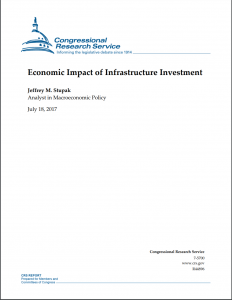Full Title: Economic Impact of Infrastructure Investment
Author(s): Jeffrey M. Stupak
Publisher(s): Congressional Research Service
Publication Date: July 1, 2017
Full Text: Download Resource
Description (excerpt):
Infrastructure investment has received renewed interest as of late, with both President Trump and some Members of Congress discussing the benefits of such spending. Infrastructure can be defined in a number of ways depending on the policy discussion; in general, however, the term refers to longer-lived, capital-intensive systems and facilities, such as roads, bridges, and water treatment facilities.
Over the past several decades, government investment in infrastructure as a percentage of gross domestic product (GDP) has declined. Annual infrastructure investment by federal, state, and local governments peaked in the late 1930s, at about 4.2% of GDP, and since has fallen to about 1.6% of GDP in 2016. State and local governments consistently spend more on infrastructure directly than the federal government. In 2016, direct federal spending on nondefense infrastructure was less than 0.1% of GDP, whereas state and local spending was about 1.5% of GDP. However, the federal government transfers some funds each year to state and local governments for capital projects, which includes infrastructure projects, equaling about 0.4% of GDP in 2016. The United States also lags many other developed countries with respect to annual infrastructure spending. Spending on infrastructure, as a percentage of GDP, is higher in all G7 countries, except for Italy and Germany, than in the United States.
